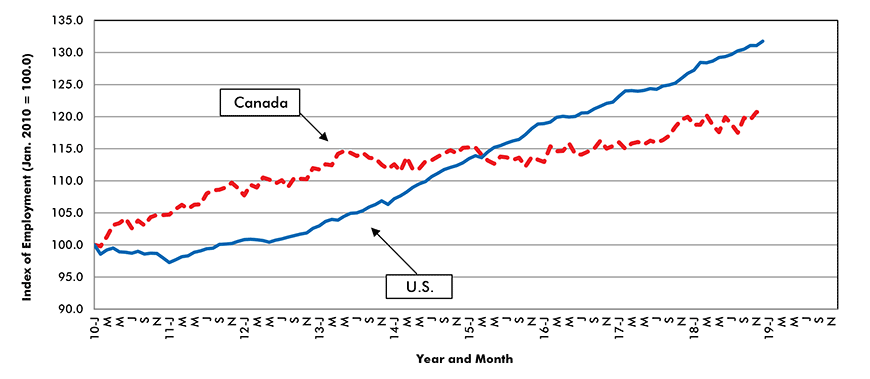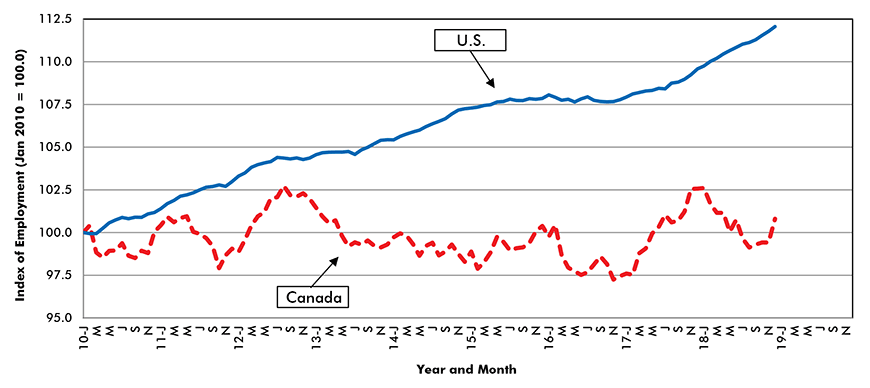The total number of jobs in the U.S. rose by +312,000 in December, according to the latest Employment Situation report from the Bureau of Labor Statistics (BLS).

There was only one other month in 2018 with a greater surge in jobs creation, February at +324,000.
Optimism over hiring prospects caused the participation rate in December to climb to 63.1% from 62.9% the month previously (i.e., more out-of-work individuals decided to rejoin the labor force). The side effect was that the unemployment rate moved up to 3.9% from 3.7% in November.
The large month-to-month gain in jobs in December understates the overall improvement, since there was also a substantial positive revision to prior data. A month ago, the BLS reported a total jobs level of 149.893 million. It is now saying that November’s figure was really 149.951 million, an increase of +58,000.
Therefore, December’s just-reported level of 150.263 million exceeds November’s first-reported level of 149.893 million by +370,000 jobs.
By industry sector, the largest revisions to November’s jobs statistics came from ‘retail’ (+18,000), ‘government’ (+16,000) and ‘leisure and hospitality’ (+14,000).
2018 was a good year for U.S. jobs growth. The monthly average employment increase was +220,000, which was an increase of +20.6% versus 2017’s monthly average rise of +182,000.
The climb in total employment from December 2017 to December 2018 was +2.6 million jobs.
The construction sector went on a hiring frenzy in the latest month, +38,000 jobs. For full-year 2018, the number of American construction jobs was +280,000, a modest improvement over 2017’s +250,000.
The average monthly increase in U.S. construction jobs in 2018 was +23,000, which was +12.0% higher than 2017’s average monthly increase of +21,000.
Construction’s not seasonally adjusted (NSA) unemployment rate in December 2018 was 5.1%, better than December 2017’s 5.9%.
The construction sector also delivered some bountiful pay increases in the latest month. Average hourly and average weekly earnings for all ‘hard hat’ workers were both +3.9% year over year. The comparable increases across the whole economy, both hourly and weekly, were +3.2%.
For ‘hard hat’ workers excluding supervisory personnel, the latest year-over-year compensation boosts were even more robust, +4.2% hourly and +4.5% weekly. Economy-wide (excluding bosses), the pay hikes were +3.3% hourly and +3.0% weekly.
The U.S. manufacturing sector also managed a big addition to payrolls in the latest month, +32,000 jobs. The full-year advance in manufacturing jobs in 2018 was +284,000, comparing favorably with 2017’s +207,000.
The monthly average increase in production-line work in 2018 was +24,000, which was more than one-third (+37.2%) higher than 2017’s comparable figure of +17,000.
Manufacturing’s NSA unemployment rate in December was a quite low 2.8%, down from November’s 2.9%; and it was also below December 2017’s 3.3%.
Other industrial sectors with large jobs pickups in December were: ‘education and health services’, +82,000; ‘leisure and hospitality’, +55,000; ‘professional and business services’, +43,000; and ‘retail trade’ (+24,000).
Nearly three-quarters of the ‘education and health services’ jobs advance originated in ‘health care and social assistance’ (+58,000 jobs). Among health care sub-sectors, ‘home health care services’ stood out with +13,000 jobs month-to-month.
The pumped-up jobs number for ‘retail trade’ (+24,000) is noteworthy because of the time of year. Yes, December is always expected to be an outstanding month for shopping, due to purchases of gifts for the holiday season. But the +24,000 figure is after seasonal adjustment, which is supposed to take account of anomalies that happen regularly from year to year. The inference is that the latest Xmas season was a more-than-usually-busy time for shopkeepers.
On a year-over-year percentage-change basis, four key metrics for the U.S. jobs market in December were: total jobs, +1.8%; services-providing employment, also +1.8%; manufacturing +2.3%; and construction, +4.0%.
The corresponding four percentage-change figures for Canada in the latest month were: total jobs, +0.9%; services jobs, +1.0%; manufacturing, -1.7%; and construction, +0.5%.
Statistics Canada’s Labour Force Survey report for December speaks of total jobs north of the border creeping forward by only +9,000.
The monthly average upturn in total Canadian jobs in 2018 was an uninspiring +14,000, a pullback of nearly two-thirds versus 2017’s comparable figure of +36,000.
There are three graphs accompanying this article – for ‘total’, ‘manufacturing’ and ‘construction’ − showing how Canadian employment has fared relative to U.S. employment since January 2010.
For ease of comparison, all the series have been indexed with January 2010 as the base or starting point. Jobs levels in following months are then expressed as a ratio of the base level or starting point. (i.e., if the jobs level rises by 25%, the index value will be 125.0).
Graph 1: Total Employment, U.S. and Canada – Since January 2010

Chart: ConstructConnect — CanaData.
Graph 2: Construction Employment, U.S. and Canada – Since January 2010

Chart: ConstructConnect — CanaData.
Graph 3: Manufacturing Employment, U.S. and Canada – Since January 2010

Chart: ConstructConnect — CanaData.
Canada hit a weak spot in total jobs creation from 2013 through 2015 but has since been mostly tracking the U.S. path higher. But in construction, and to an even greater extent manufacturing, Canada has not been keeping up on the jobs-creation front.
Canada’s unemployment rate in December stayed the same as in November, at 5.6%.
Regionally, the lowest jobless rates in the country currently are in British Columbia (4.4%), Ontario (5.4%) and Quebec (5.5%).
Ontario has been the province providing the greatest number of new jobs over the past year, +78,000. B.C., with +44,000 jobs, has been the runner-up.
Alberta shed 17,000 jobs in December, but achieved a decent result year-over-year, +22,000.











Recent Comments